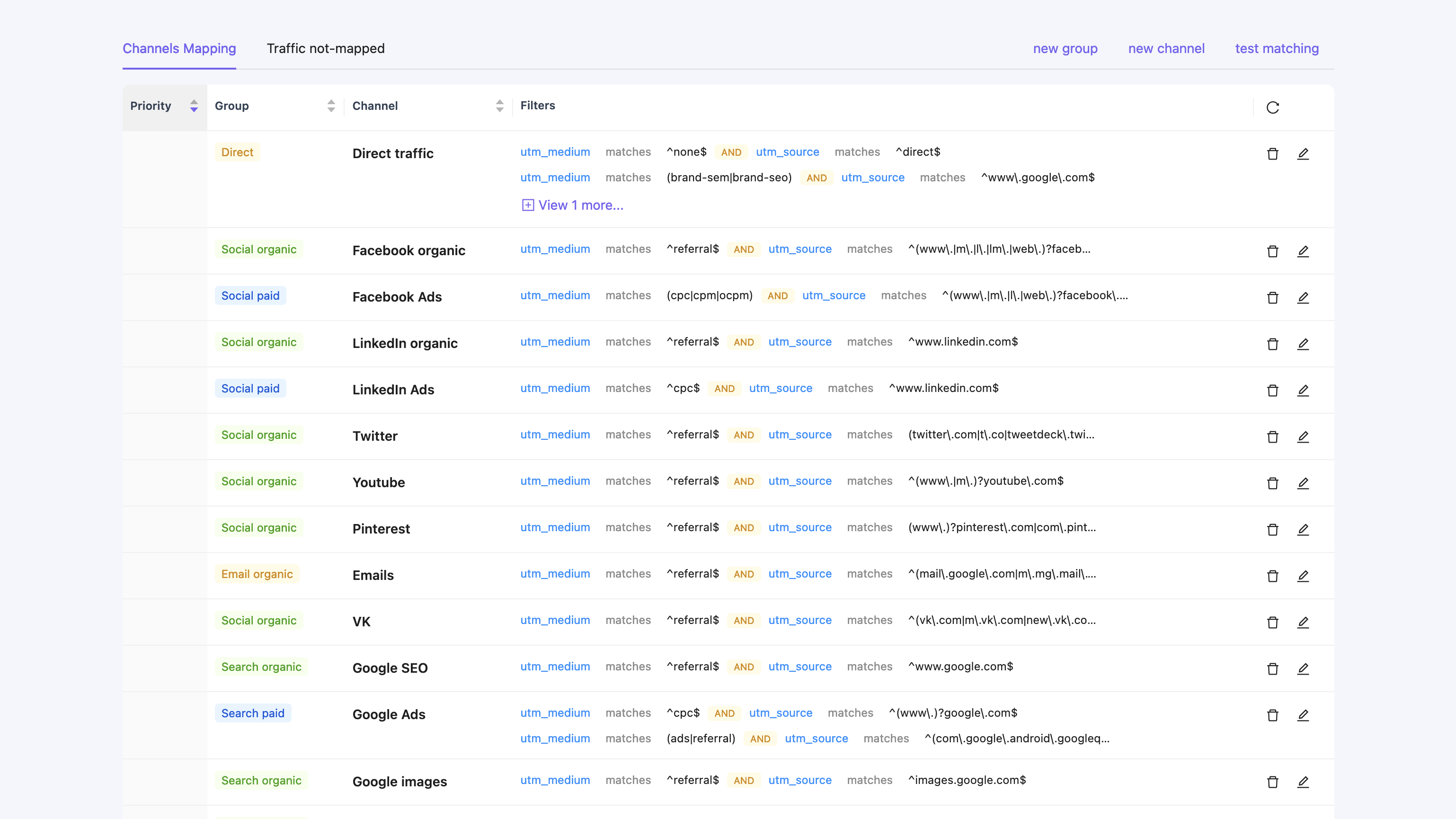To group together your traffic sources, and analyze their performance, you can map them to your marketing channels.
By default, a list of common traffic sources is already created for you (Google SEO, Google Ads, Facebook Ads, TikTok Ads, etc…). However it is important to map your significant traffic sources to your marketing channels, otherwise they will be grouped as “not mapped”.
Structure
A channel belongs to a group, and a group can have multiple channels.
Each channel contain a list of filters that will be applied to match the traffic sources.
In case of overlap, the channel having the highest priority will be applied.
A filter is made of a list of dimensions (utm_source, utm_medium, utm_campaign, landing_path, utm_id_from) with a condition (contains, match…).

UTM parameters
UTM parameters are a set of parameters used in URLs to track traffic sources and campaigns. They are the core pillars of digital marketing measurement.
| UTM Parameter | Description |
|---|
| utm_source | Identifies the source of your traffic (e.g., google.com, facebook.com, mybusiness.com) |
| utm_medium | Indicates the marketing medium (e.g., referral, ads, cpc, email, social) |
| utm_campaign | Specifies the specific campaign name (e.g., black-friday-2025) |
| utm_term | Used for paid search to note the keywords for this ad |
| utm_content | Differentiates similar content or links within the same ad or page (e.g., ad-v1, ad-v2) |
Example
For an emailing campaign, the UTM parameters will be:
- utm_source:
mybusiness.com
- utm_medium:
email
- utm_campaign:
black-friday-2025
- utm_content:
email-v1 / email-v2 … if you do A/B testing
For a paid Instagram campaign, the UTM parameters will be:
- utm_source:
instagram.com
- utm_medium:
social or ads
- utm_campaign:
black-friday-2025
- utm_content:
black-friday-2025-v1 / black-friday-2025-v2 … if you do A/B testing
For a Search paid campaign, the UTM parameters will be:
- utm_source:
google.com
- utm_medium:
ads
- utm_campaign:
black-friday-2025
- utm_term:
[your keywords]
- utm_content:
black-friday-2025-v1 / black-friday-2025-v2 … if you do A/B testing
| Parameter | Description |
|---|
| utm_id | Staminads stores the ad-networks click IDs (Google Ads gclid, Meta fbclid…) in the utm_id dimension in the Staminads database. |
| utm_id_from | Staminads stores the origin of the utm_id in the utm_id_from dimension in the Staminads database (e.g., gclid, fbclid, msclkid…). |
https://www.yourdomain.com?utm_source=google&utm_medium=cpc&utm_campaign=black-friday-2025&gclid=Cj0KCAiAxea5BhBeEi0Ah4t5K1MSznUElMY.
In this case the utm_id dimension will be Cj0KCAiAxea5BhBeEi0Ah4t5K1MSznUElMY and the utm_id_from dimension will be gclid.
Brand organic traffic
Nowadays, most people who are already familiar with your brand will search for it directly on Google. This traffic, which comes from Google’s organic search results, should actually be considered direct traffic. If not properly categorized, it will be mixed with other organic search traffic and affect the accuracy of your organic TimeScores.
The particularity of this traffic is that the landing-page is always the root domain (e.g., https://www.yourdomain.com).
To map this traffic, you can create a new channel with the following filter:
- landing_path
equals /
- utm_source
contains .google.
- utm_medium
equals referral
- utm_id_from
does not exist

